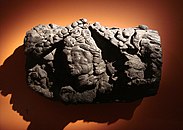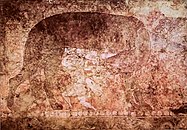
Ya'qūb ibn al-Layth al-Saffār, was a coppersmith and the founder of the Saffarid dynasty of Sistan, with its capital at Zaranj. Under his military leadership, he conquered much of the eastern portions of Greater Iran consisting of modern-day Iran, Afghanistan, Turkmenistan, Uzbekistan, Tajikistan as well as portions of western Pakistan and a small part of Iraq. He was succeeded by his brother, Amr ibn al-Layth.
The Kidarites, or Kidara Huns, were a dynasty that ruled Bactria and adjoining parts of Central Asia and South Asia in the 4th and 5th centuries. The Kidarites belonged to a complex of peoples known collectively in India as the Huna, and in Europe as the Chionites, and may even be considered as identical to the Chionites. The 5th century Byzantine historian Priscus called them Kidarite Huns, or "Huns who are Kidarites". The Huna/Xionite tribes are often linked, albeit controversially, to the Huns who invaded Eastern Europe during a similar period. They are entirely different from the Hephthalites, who replaced them about a century later.

Amr ibn al-Layth or Amr-i Laith Saffari was the second ruler of the Saffarid dynasty of Iran from 879 to 901. He was the son of a whitesmith and the younger brother of the dynasty's founder, Ya'qub ibn al-Layth al-Saffar.
Muhammad ibn Abi'l-Saj also known as Muhammad al-Afshin, an Iranian appointed general of al-Mu'tadid, He was the founder of Sajid dynasty and governor of Azerbaijan, from 889 or 890 until his death. He was the son of Abi'l-Saj Devdad.

Osrušana or Ustrushana was a former Iranian region in Transoxiana, home to the Principality of Ushrusana, an important pre-Islamic polity of Central Asia. Oshrusana lay to the south of the great, southernmost bend of the Syr Darya and extended roughly from Samarkand to Khujand. The capital city of Oshrusana was Bunjikat. The exact form of the Iranian name Osrušana is not clear from the sources, but the forms given in Hudud al-'alam, indicate an original *Sorušna.

Ḥaydar ibn Kāwūs, better known by his hereditary title of al-Afshīn, was a senior general of Sogdian Iranian descent at the court of the Abbasid caliphs and a vassal prince of Oshrusana. He played a leading role in the campaigns of Caliph al-Mu'tasim, and was responsible for the suppression of the rebellion of Babak Khorramdin and for his battlefield victory over the Byzantine emperor Theophilos during the Amorium campaign. Eventually he was suspected of disloyalty and was arrested, tried and then executed in June 841.
Abu Ja'far Ashinas was a general of the Abbasid caliph Al-Mu'tasim. One of the earliest and most prominent members of al-Mu'tasim's Turkic guard, he rose to become one of the leading figures of the empire under al-Mu'tasim, serving as a commander in the Amorium campaign, and playing a leading role in the purge of the old Abbasid elites that followed. He was also governor of Egypt from 834, as well as of the Levant and Upper Mesopotamia from 838 on, although in practice he appointed deputies to govern in his stead. Under al-Mu'tasim's successor al-Wathiq, his powers were extended further into a virtual viceroyalty over all western provinces of the caliphate.
Sind was an administrative division of the Umayyad Caliphate and later of the Abbasid Caliphate in post-classical India, from around 711 CE with the Umayyad conquest of Sindh by the Arab military commander Muhammad ibn al-Qasim, to around 854 CE with the emergence of the independent dynasties of the Habbarid Emirate and the Emirate of Multan. The "Governor of Sind" was an official who administered the caliphal province over what are now Sindh and South Punjab in Pakistan, with Makran in Balochistan also usually being under his control.
The Faraghina were a regiment in the regular army of the Abbasid Caliphate which was active during the ninth century A.D. Consisting of troops who originated from the region of Farghana in Transoxiana, the Faraghina participated in several military campaigns and played a significant role in the politics of the central government, especially during the Anarchy at Samarra.
Abu Ja'far Ahmad ibn Isra'il al-Anbari was a prominent civil officer of the Abbasid Caliphate in the mid-9th century, serving as vizier during the caliphate of al-Mu'tazz. His career came to a sudden end when he was arrested on the orders of the Turkish general Salih ibn Wasif in May 869, and he was killed four months later after being repeatedly subjected to torture.
The Ushrusaniyya were a regiment in the regular army of the Abbasid Caliphate. Formed in the early ninth century A.D., the unit consisted of soldiers who were originally from the region of Ushrusana in Transoxiana. The Ushrusaniyya initially served under the prominent general al-Afshin, but they remained active after his downfall, and are frequently mentioned during the period known as the Anarchy at Samarra.
Mankjur or Minkajur al-Farghani or al-Ushrusani was a 9th-century Iranian military officer in the service of the Abbasid Caliphate. He was a cousin of the prominent Abbasid general Khaydhar ibn Kawus al-Afshin, thus belonging to the ruling family of Ushrusana. Mankjur accompanied al-Afshin in his campaign against the Khurramite Babak Khorramdin, and was later appointed as governor of Adharbayjan by him in 837. However, in 839, Mankjur, after refusing to give the caliph al-Mu'tasim some of Babak's booty, revolted against him. Al-Mu'tasim responded by sending against him Bugha al-Kabir, who managed to suppress his revolt and imprison him in Samarra. The affair of Mankjur raised suspicions about the loyalty of the al-Afshin, who was accused of encouraging the revolt, and contributed to the general's own downfall in the following year.
Kawus ibn Kharakhuruh was the ruler of the Principality of Ushrusana during the 9th-century. He was the son and successor of Kharakhuruh.

The Principality of Chaghaniyan, known in Arabic sources as al-Saghaniyan, was a part of the Hephthalite Confederation from the 5th to the 7th century CE. After this, it was ruled by a local, presumably Iranian dynasty, which governed the Chaghaniyan region from the late 7th-century to the early 8th-century CE. These rulers were known by their titles of “Chaghan Khudah”.
Abu al-'Abbas Ahmad ibn al-Khasib al-Jarjara'i was a civil officer of the Abbasid Caliphate in the mid-9th century, serving as vizier during the caliphate of al-Muntasir. A major figure in the first year of the period known as the Anarchy at Samarra, his career at the caliphal court came to an end when he was forced into exile in mid-862.
Isa ibn Mansur al-Rafiqi, alternatively known as al-Rafi'i, was a governor of Egypt for the Abbasid Caliphate, holding that position from 831 to 832 and again from 843 to 847.
Harthamah ibn al-Nadral-Jabali was a ninth century provincial governor for the Abbasid Caliphate, serving as governor of Egypt from 847 until his death in 849.
Abu al-Husayn Ishaq ibn Ibrahim was a ninth-century official in the service of the Abbasid Caliphate. A member of the Mus'abid family, he was related to the Tahirid governors of Khurasan, and was himself a prominent enforcer of caliphal policy during the reigns of al-Ma'mun, al-Mu'tasim, al-Wathiq, and al-Mutawakkil.
Muḥammad ibn ʿAbd al-Malik, better known as Ibn al-Zayyāt, was a wealthy merchant who became a court official and served as vizier of the Abbasid caliphs al-Mu'tasim, al-Wathiq, and al-Mutawakkil, from 836 until his downfall and death by torture in 847.

Rakhanch was a Sogdian Afshin (ruler) of the Principality of Ushrusana, modern Tajikistan, in the 7th century CE, in the period between 600 and 720 CE.




















